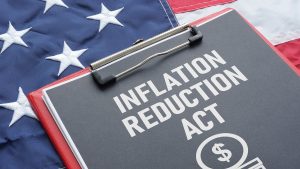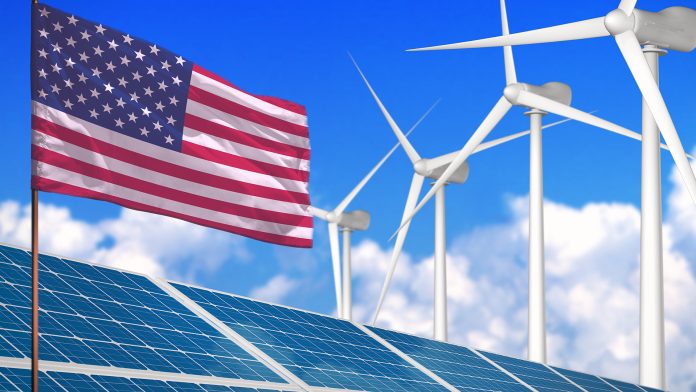The Inflation Reduction Act of 2022, landmark legislation on climate change, has undoubtedly set the United States on a transformative path towards clean energy leadership.
The Act has revitalised the domestic energy sector by investing $115 billion in clean energy technology and manufacturing so far, sparking enthusiasm and debate in equal measure.
However, the Act’s potential influence extends beyond US borders, touching global clean energy supply chains and raising critical questions about international trade dynamics and national security.
How are clean energy supply chains reflected in the Inflation Reduction Act?
The Inflation Reduction Act is a monumental piece of legislation characterised by diverse provisions designed to invigorate the clean energy sector and reduce greenhouse gas emissions, therefore reshaping the American energy landscape.
This legislation has significant implications for the United States, the global energy sector, and our collective efforts to achieve environmental sustainability.
Impact analysis of the Act reveals a forward-thinking approach towards creating economic benefits. These are expected to be realised through increased investment in the clean energy sector and the creation of new jobs.
The Act also aims to strengthen the resilience of energy supply chains by diversifying sources and reducing dependence on foreign oil.
It also recognises the importance of global partnerships. It seeks to inspire international cooperation in the fight against climate change while gaining a competitive edge in the global clean energy market. The legislation promotes the sharing of technological advancements and collaborative efforts in research and development, thus fostering an international community committed to environmental sustainability.

However, perhaps the most crucial aspect of this legislation is its focus on supply chain resilience. The Act aims to create a more stable and reliable energy supply chain by encouraging domestic production and incentivising industries vital to US national security.
This focus on resilience serves the dual purpose of creating economic opportunities at home while reducing vulnerability to external supply shocks and geopolitical instability.
Policy recommendations for energy resources
Building on the implications of the Inflation Reduction Act for clean energy supply chains, a set of strategic policy recommendations emerges to bolster further the Bureau of Energy Resources’ efforts to foster a resilient and sustainable energy landscape.
These recommendations focus on international partnerships, resource sustainability, private investment, diplomatic engagement, and the importance of critical minerals.
Firstly, strengthening international partnerships is crucial in promoting resource sustainability. This can be achieved through multilateral agreements on clean energy technology and the development of ethical sourcing for critical minerals. It is recommended that the US expand the Mineral Security Partnership (MSP) to include more nations committed to MSP principles and create a ‘Battery Passport’ to facilitate the trade of ethically sourced battery components among member states.
Private investment is also critical in transitioning to a clean energy future. The US government can support private firms and entrepreneurs by forming diplomatic and expert task forces to secure deals with emerging economies vital to clean energy supply chains.
Moreover, diplomatic engagement can ensure international cooperation. Encouraging Free Trade Agreements, including bilateral critical mineral agreements, with international partners can foster global collaboration.
Lastly, critical minerals are essential to clean energy technologies. The US should establish a Strategic Critical Mineral Stockpile among MSP member states to ensure a steady supply.
Evolution of the US manufacturing sector
Since the turn of the new millennium, significant changes have swept across the United States manufacturing sector, partially due to the rise of Chinese competitive pressures.
The sector has undergone an evolution analysis, rebalancing towards industries where the US holds a comparative advantage. Future trends, such as technological advancements and market competition, have driven this transformation.
While this shift has had a global impact, particularly on supply chains, it has also made the sector more resilient and competitive. With the help of the Inflation Reduction Act, the US manufacturing sector is now strategically positioned to lead the global transition towards clean energy.
Looking ahead, the manufacturing sector is expected to continue evolving in response to the potential offered by the clean energy transition.
The Inflation Reduction Act, coupled with technological advancements and market competition, has the potential to transform the US into a global leader in clean energy.
Critical investments in infrastructure and manufacturing
Under President Biden’s administration, significant legislative strides in infrastructure and manufacturing have been made, as evidenced by the Infrastructure Investment and Jobs Act (IIJA), the CHIPS and Science Act, and the Inflation Reduction Act.
These acts collectively represent an unprecedented commitment towards enhancing infrastructure, advancing manufacturing capabilities, and promoting clean energy transition. The impact analysis of these critical investments reveals a strategic plan to strengthen supply chain resilience, stimulate investment opportunities, and ensure regulatory compliance.
The IIJA, for instance, earmarks over $1tr for infrastructure improvement, focusing on traditional areas like roads and bridges while prioritising clean energy and digital infrastructure.
The CHIPS Act, on the other hand, targets domestic semiconductor production, an apparent move to fortify the technology supply chain.
The IRA, however, stands out as the most pertinent to our discussion on clean energy supply chains. This act directs substantial funding towards clean energy tax credits, air pollution regulation, and clean manufacturing tax credits, among other things. It underlines the administration’s commitment to a more sustainable, resilient, and domestically-centred clean energy supply chain.
This legislative push also encourages global partnerships. As US firms align their strategies with the provisions of these acts, we foresee an increase in international collaborations.
These partnerships will ensure supply chain resilience and open up new investment opportunities.
Environmental implications of the IRA
In assessing the environmental implications of the Inflation Reduction Act, it’s crucial to examine the legislation’s potential to reduce greenhouse gas emissions and promote sustainable energy practices.
The IRA is a significant step towards US commitments to climate resilience, with various strategies in place to ensure sustainable practices in clean energy development.
An impact assessment of the IRA suggests promising outcomes. The Act seeks to mobilise government agencies and the private sector to develop efficient, resilient, sustainable clean energy supply chains.
Climate models indicate that the IRA could help the US achieve up to 84% of its emissions reduction goal, a significant stride towards mitigating climate change.
Global partnerships are central to the IRA’s approach. The Act promotes reshaping supply chains to align with US geostrategic interests and encourages sourcing from partners based in allied countries. Diversifying can enhance supply shock resilience and encourage ethical sourcing in clean energy supply chains.
In essence, the IRA is a robust policy instrument designed to promote environmental sustainability, foster global partnerships, and achieve significant reductions in greenhouse gas emissions.
Strategic motivations behind the IRA
Building on the environmental implications of the Inflation Reduction Act, it is crucial to understand the critical strategic motivations that fuelled its creation and implementation.
The Act was a response to inflation pressures and a strategic initiative to ensure America’s economic competitiveness and energy security in a rapidly changing world.
Impact analysis of the IRA reveals an intent to reposition the US as a global leader in clean energy. The Act seeks to stimulate the domestic clean energy sector by offering tax incentives, investment initiatives, and sustainable development.
This approach aligns with the broader objective of enhancing energy security, reducing dependency on fossil fuels, and fostering resilience against global supply chain shocks.
A significant strategic motivation behind the IRA was creating and nurturing global partnerships. The Act encourages cooperation with international partners, seeking to forge alliances that strengthen clean energy supply chains. These partnerships aim to create a more diversified supply, increase resilience, and promote economic competitiveness.
Finally, the IRA promotes sustainable development, integrating economic growth with environmental stewardship. By incentivising clean energy, the Act contributes to the global effort to combat climate change while creating new opportunities for American businesses.
Future impact on global clean energy supply chains
The Act’s core purpose is to bolster the United States’ position in the clean energy industry, thereby reducing reliance on foreign energy sources and creating a more sustainable and resilient economy.
The Act’s overview reveals funding provisions totalling $370bn. This funding is dedicated to tax incentives and investment initiatives to increase supply and demand within the clean energy sector.
The implications of these provisions could potentially reshape the energy industry’s landscape, creating a more competitive and sustainable market.
An in-depth analysis of the Act’s provisions demonstrates an explicit emphasis on domestic clean energy production. This has garnered criticism from international partners, who view these provisions as a barrier to free trade.
However, these provisions’ benefits for the US economy cannot be understated, as they promote local industry and employment opportunities.
The impact of the Act’s provisions on the global clean energy supply chains is expected to be significant. By incentivising domestic production, the Act could disrupt existing supply chains, forcing companies to reevaluate their sourcing and manufacturing strategies.
This could lead to a greater diversification of clean energy sources, ultimately promoting sustainability and resilience in the face of potential supply shocks.









